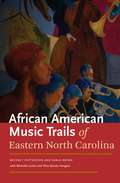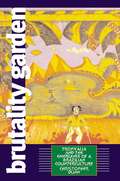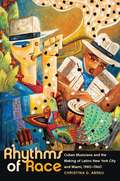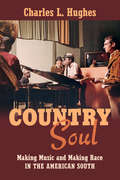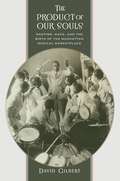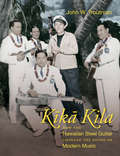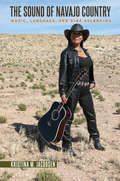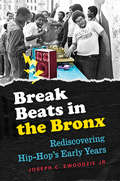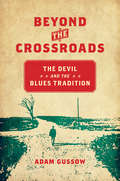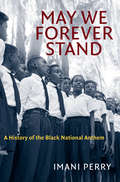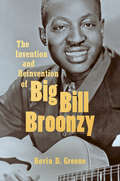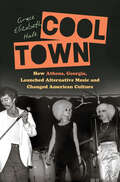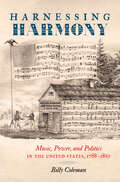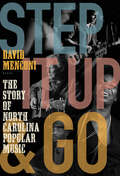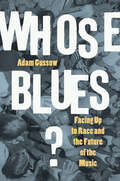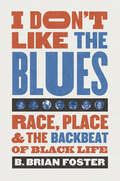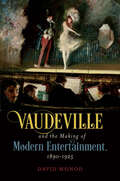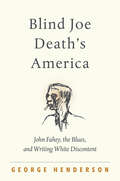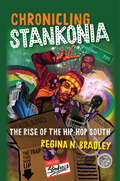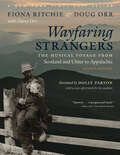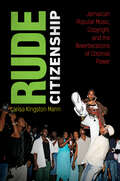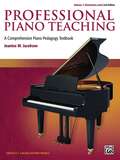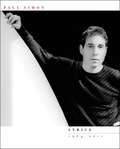- Table View
- List View
African American Music Trails of Eastern North Carolina
by Sarah Bryan Beverly Patterson Michelle LanierThelonius Monk, Billy Taylor, and Maceo Parker--famous jazz artists who have shared the unique sounds of North Carolina with the world--are but a few of the dynamic African American artists from eastern North Carolina featured in The African American Music Trails of Eastern North Carolina. This first-of-its-kind travel guide will take you on a fascinating journey to music venues, events, and museums that illuminate the lives of the musicians and reveal the deep ties between music and community. Interviews with more than 90 artists open doors to a world of music, especially jazz, rhythm and blues, funk, gospel and church music, blues, rap, marching band music, and beach music. New and historical photographs enliven the narrative, and maps and travel information help you plan your trip. Included is a CD with 17 recordings performed by some of the region's outstanding artists.
Brutality Garden
by Christopher DunnIn the late 1960s, Brazilian artists forged a watershed cultural movement known as Tropicalia. Music inspired by that movement is today enjoying considerable attention at home and abroad. Few new listeners, however, make the connection between this music and the circumstances surrounding its creation, the most violent and repressive days of the military regime that governed Brazil from 1964 to 1985. With key manifestations in theater, cinema, visual arts, literature, and especially popular music, Tropicalia dynamically articulated the conflicts and aspirations of a generation of young, urban Brazilians.Focusing on a group of musicians from Bahia, an impoverished state in northeastern Brazil noted for its vibrant Afro-Brazilian culture, Christopher Dunn reveals how artists including Caetano Veloso, Gilberto Gil, Gal Costa, and Tom Ze created this movement together with the musical and poetic vanguards of Sao Paulo, Brazil's most modern and industrialized city. He shows how the tropicalists selectively appropriated and parodied cultural practices from Brazil and abroad in order to expose the fissure between their nation's idealized image as a peaceful tropical "garden" and the daily brutality visited upon its citizens.
The New Encyclopedia of Southern Culture: Music
by Bill C. MaloneSouthern music has flourished as a meeting ground for the traditions of West African and European peoples in the region, leading to the evolution of various traditional folk genres, bluegrass, country, jazz, gospel, rock, blues, and southern hip-hop. This much-anticipated volume in The New Encyclopedia of Southern Culture celebrates an essential element of southern life and makes available for the first time a stand-alone reference to the music and music makers of the American South.With nearly double the number of entries devoted to music in the original Encyclopedia, this volume includes 30 thematic essays, covering topics such as ragtime, zydeco, folk music festivals, minstrelsy, rockabilly, white and black gospel traditions, and southern rock. And it features 174 topical and biographical entries, focusing on artists and musical outlets. From Mahalia Jackson to R.E.M., from Doc Watson to OutKast, this volume considers a diverse array of topics, drawing on the best historical and contemporary scholarship on southern music. It is a book for all southerners and for all serious music lovers, wherever they live.
Rhythms of Race
by Christina D. AbreuAmong the nearly 90,000 Cubans who settled in New York City and Miami in the 1940s and 1950s were numerous musicians and entertainers, black and white, who did more than fill dance halls with the rhythms of the rumba, mambo, and cha cha cha. In her history of music and race in midcentury America, Christina D. Abreu argues that these musicians, through their work in music festivals, nightclubs, social clubs, and television and film productions, played central roles in the development of Cuban, Afro-Cuban, Latino, and Afro-Latino identities and communities. Abreu draws from previously untapped oral histories, cultural materials, and Spanish-language media to uncover the lives and broader social and cultural significance of these vibrant performers.Keeping in view the wider context of the domestic and international entertainment industries, Abreu underscores how the racially diverse musicians in her study were also migrants and laborers. Her focus on the Cuban presence in New York City and Miami before the Cuban Revolution of 1959 offers a much needed critique of the post-1959 bias in Cuban American studies as well as insights into important connections between Cuban migration and other twentieth-century Latino migrations.
Country Soul: Making Music and Making Race in the American South
by Charles L. HughesIn the sound of the 1960s and 1970s, nothing symbolized the rift between black and white America better than the seemingly divided genres of country and soul. Yet the music emerged from the same songwriters, musicians, and producers in the recording studios of Memphis and Nashville, Tennessee, and Muscle Shoals, Alabama--what Charles L. Hughes calls the "country-soul triangle." In legendary studios like Stax and FAME, integrated groups of musicians like Booker T. and the MGs and the Muscle Shoals Rhythm Section produced music that both challenged and reconfirmed racial divisions in the United States. Working with artists from Aretha Franklin to Willie Nelson, these musicians became crucial contributors to the era's popular music and internationally recognized symbols of American racial politics in the turbulent years of civil rights protests, Black Power, and white backlash. Hughes offers a provocative reinterpretation of this key moment in American popular music and challenges the conventional wisdom about the racial politics of southern studios and the music that emerged from them. Drawing on interviews and rarely used archives, Hughes brings to life the daily world of session musicians, producers, and songwriters at the heart of the country and soul scenes. In doing so, he shows how the country-soul triangle gave birth to new ways of thinking about music, race, labor, and the South in this pivotal period.
The Product of Our Souls
by David GilbertIn 1912 James Reese Europe made history by conducting his 125-member Clef Club Orchestra at Carnegie Hall. The first concert by an African American ensemble at the esteemed venue was more than just a concert--it was a political act of desegregation, a defiant challenge to the status quo in American music. In this book, David Gilbert explores how Europe and other African American performers, at the height of Jim Crow, transformed their racial difference into the mass-market commodity known as "black music." Gilbert shows how Europe and others used the rhythmic sounds of ragtime, blues, and jazz to construct new representations of black identity, challenging many of the nation's preconceived ideas about race, culture, and modernity and setting off a musical craze in the process.Gilbert sheds new light on the little-known era of African American music and culture between the heyday of minstrelsy and the Harlem Renaissance. He demonstrates how black performers played a pioneering role in establishing New York City as the center of American popular music, from Tin Pan Alley to Broadway, and shows how African Americans shaped American mass culture in their own image.
Kika Kila: How the Hawaiian Steel Guitar Changed the Sound of Modern Music
by John W. TroutmanSince the nineteenth century, the distinct tones of k&299;k&257; kila, the Hawaiian steel guitar, have defined the island sound. Here historian and steel guitarist John W. Troutman offers the instrument's definitive history, from its discovery by a young Hawaiian royalist named Joseph Kekuku to its revolutionary influence on American and world music. During the early twentieth century, Hawaiian musicians traveled the globe, from tent shows in the Mississippi Delta, where they shaped the new sounds of country and the blues, to regal theaters and vaudeville stages in New York, Berlin, Kolkata, and beyond. In the process, Hawaiian guitarists recast the role of the guitar in modern life. But as Troutman explains, by the 1970s the instrument's embrace and adoption overseas also worked to challenge its cultural legitimacy in the eyes of a new generation of Hawaiian musicians. As a consequence, the indigenous instrument nearly disappeared in its homeland.Using rich musical and historical sources, including interviews with musicians and their descendants, Troutman provides the complete story of how this Native Hawaiian instrument transformed not only American music but the sounds of modern music throughout the world.
The Sound of Navajo Country: Music, Language, and Diné Belonging (Critical Indigeneities)
by Kristina M. JacobsenIn this ethnography of Navajo (Diné) popular music culture, Kristina M. Jacobsen examines questions of Indigenous identity and performance by focusing on the surprising and vibrant Navajo country music scene. Through multiple first-person accounts, Jacobsen illuminates country music’s connections to the Indigenous politics of language and belonging, examining through the lens of music both the politics of difference and many internal distinctions Diné make among themselves and their fellow Navajo citizens. As the second largest tribe in the United States, the Navajo have often been portrayed as a singular and monolithic entity. Using her experience as a singer, lap steel player, and Navajo language learner, Jacobsen challenges this notion, showing the ways Navajos distinguish themselves from one another through musical taste, linguistic abilities, geographic location, physical appearance, degree of Navajo or Indian blood, and class affiliations. By linking cultural anthropology to ethnomusicology, linguistic anthropology, and critical Indigenous studies, Jacobsen shows how Navajo poetics and politics offer important insights into the politics of Indigeneity in Native North America, highlighting the complex ways that identities are negotiated in multiple, often contradictory, spheres.
Break Beats in the Bronx: Rediscovering Hip-Hop's Early Years
by Joseph C. EwoodzieThe origin story of hip-hop—one that involves Kool Herc DJing a house party on Sedgwick Avenue in the Bronx—has become received wisdom. But Joseph C. Ewoodzie Jr. argues that the full story remains to be told. In vibrant prose, he combines never-before-used archival material with searching questions about the symbolic boundaries that have divided our understanding of the music. In Break Beats in the Bronx, Ewoodzie portrays the creative process that brought about what we now know as hip-hop and shows that the art form was a result of serendipitous events, accidents, calculated successes, and failures that, almost magically, came together. In doing so, he questions the unexamined assumptions about hip-hop's beginnings, including why there are just four traditional elements—DJing, MCing, breaking, and graffiti writing—and not others, why the South Bronx and not any other borough or city is considered the cradle of the form, and which artists besides Kool Herc, Afrika Bambaataa, and Grandmaster Flash founded the genre. Ewoodzie answers these and many other questions about hip-hop's beginnings. Unearthing new evidence, he shows what occurred during the crucial but surprisingly underexamined years between 1975 and 1979 and argues that it was during this period that the internal logic and conventions of the scene were formed.
Beyond the Crossroads: The Devil and the Blues Tradition (New Directions in Southern Studies)
by Adam GussowThe devil is the most charismatic and important figure in the blues tradition. He's not just the music's namesake ("the devil's music"), but a shadowy presence who haunts an imagined Mississippi crossroads where, it is claimed, Delta bluesman Robert Johnson traded away his soul in exchange for extraordinary prowess on the guitar. Yet, as scholar and musician Adam Gussow argues, there is much more to the story of the devil and the blues than these cliched understandings.In this groundbreaking study, Gussow takes the full measure of the devil's presence. Working from original transcriptions of more than 125 recordings released during the past ninety years, Gussow explores the varied uses to which black southern blues people have put this trouble-sowing, love-wrecking, but also empowering figure. The book culminates with a bold reinterpretation of Johnson's music and a provocative investigation of the way in which the citizens of Clarksdale, Mississippi, managed to rebrand a commercial hub as "the crossroads" in 1999, claiming Johnson and the devil as their own.
May We Forever Stand: A History of the Black National Anthem (The John Hope Franklin Series in African American History and Culture)
by Imani PerryThe twin acts of singing and fighting for freedom have been inseparable in African American history. May We Forever Stand tells an essential part of that story. With lyrics penned by James Weldon Johnson and music composed by his brother Rosamond, "Lift Every Voice and Sing" was embraced almost immediately as an anthem that captured the story and the aspirations of black Americans. Since the song's creation, it has been adopted by the NAACP and performed by countless artists in times of both crisis and celebration, cementing its place in African American life up through the present day. In this rich, poignant, and readable work, Imani Perry tells the story of the Black National Anthem as it traveled from South to North, from civil rights to black power, and from countless family reunions to Carnegie Hall and the Oval Office. Drawing on a wide array of sources, Perry uses "Lift Every Voice and Sing" as a window on the powerful ways African Americans have used music and culture to organize, mourn, challenge, and celebrate for more than a century.
The Invention and Reinvention of Big Bill Broonzy
by Kevin D. GreeneOver the course of his long career, legendary bluesman William "Big Bill" Broonzy (1893–1958) helped shape the trajectory of the genre, from its roots in the rural Mississippi River Delta, through its rise as a popular genre in the North, to its eventual international acclaim. Along the way, Broonzy adopted an evolving personal and professional identity, tailoring his self-presentation to the demands of the place and time. His remarkable professional fluidity mirrored the range of expectations from his audiences, whose ideas about race, national belonging, identity, and the blues were refracted through Broonzy as if through a prism. Kevin D. Greene argues that Broonzy's popular success testifies to his ability to navigate the cultural expectations of his different audiences. However, this constant reinvention came at a personal and professional cost. Using Broonzy's multifaceted career, Greene situates blues performance at the center of understanding African American self-presentation and racial identity in the first half of the twentieth century. Through Broonzy's life and times, Greene assesses major themes and events in African American history, including the Great Migration, urbanization, and black expatriate encounters with European culture consumers. Drawing on a range of historical source materials as well as oral histories and personal archives held by Broonzy's son, Greene perceptively interrogates how notions of race, gender, and audience reception continue to shape concepts of folk culture and musical authenticity.
Cool Town: How Athens, Georgia, Launched Alternative Music and Changed American Culture (A Ferris and Ferris Book)
by Grace Elizabeth HaleIn the summer of 1978, the B-52's conquered the New York underground. A year later, the band's self-titled debut album burst onto the Billboard charts, capturing the imagination of fans and music critics worldwide. The fact that the group had formed in the sleepy southern college town of Athens, Georgia, only increased the fascination. Soon, more Athens bands followed the B-52's into the vanguard of the new American music that would come to be known as "alternative," including R.E.M., who catapulted over the course of the 1980s to the top of the musical mainstream. As acts like the B-52's, R.E.M., and Pylon drew the eyes of New York tastemakers southward, they discovered in Athens an unexpected mecca of music, experimental art, DIY spirit, and progressive politics--a creative underground as vibrant as any to be found in the country's major cities. In Athens in the eighties, if you were young and willing to live without much money, anything seemed possible. Cool Town reveals the passion, vitality, and enduring significance of a bohemian scene that became a model for others to follow. Grace Elizabeth Hale experienced the Athens scene as a student, small-business owner, and band member. Blending personal recollection with a historian's eye, she reconstructs the networks of bands, artists, and friends that drew on the things at hand to make a new art of the possible, transforming American culture along the way. In a story full of music and brimming with hope, Hale shows how an unlikely cast of characters in an unlikely place made a surprising and beautiful new world.
Harnessing Harmony: Music, Power, and Politics in the United States, 1788–1865
by Billy ColemanFollowing the creation of the United States, profound disagreements remained over how to secure the survival of the republic and unite its diverse population. In this pathbreaking account, Billy Coleman uses the history of American music to illuminate the relationship between elite power and the people from the early national period to the Civil War. Based on deep archival research in sources such as music periodicals, songbooks, and manuals for musical instruction, Coleman argues that a particular ideal of musical power provided conservative elites with an attractive road map for producing the harmonious union they desired. He reassesses the logic behind the decision to compose popular patriotic anthems like "The Star-Spangled Banner," reconsiders the purpose of early American campaign songs, and brings to life a host of often forgotten but fascinating musical organizations and individuals. The result is not only a striking interpretation of music in American political life but also a fresh understanding of conflicts that continue to animate American democracy.
Step It Up and Go: The Story of North Carolina Popular Music, from Blind Boy Fuller and Doc Watson to Nina Simone and Superchunk
by David MenconiThis book is a love letter to the artists, scenes, and sounds defining North Carolina's extraordinary contributions to American popular music. David Menconi spent three decades immersed in the state's music, where traditions run deep but the energy expands in countless directions. Menconi shows how working-class roots and rebellion tie North Carolina's Piedmont blues, jazz, and bluegrass to beach music, rock, hip-hop, and more. From mill towns and mountain coves to college-town clubs and the stage of American Idol, Blind Boy Fuller and Doc Watson to Nina Simone and Superchunk, Step It Up and Go celebrates homegrown music just as essential to the state as barbecue and basketball.Spanning a century of history from the dawn of recorded music to the present, and with sidebars and photos that help reveal the many-splendored glory of North Carolina's sonic landscape, this is a must-read for every music lover.
Whose Blues?: Facing Up to Race and the Future of the Music
by Adam GussowMamie Smith's pathbreaking 1920 recording of "Crazy Blues" set the pop music world on fire, inaugurating a new African American market for "race records." Not long after, such records also brought black blues performance to an expanding international audience. A century later, the mainstream blues world has transformed into a multicultural and transnational melting pot, taking the music far beyond the black southern world of its origins. But not everybody is happy about that. If there's "No black. No white. Just the blues," as one familiar meme suggests, why do some blues people hear such pronouncements as an aggressive attempt at cultural appropriation and an erasure of traumatic histories that lie deep in the heart of the music? Then again, if "blues is black music," as some performers and critics insist, what should we make of the vibrant global blues scene, with its all-comers mix of nationalities and ethnicities? In Whose Blues?, award-winning blues scholar and performer Adam Gussow confronts these challenging questions head-on. Using blues literature and history as a cultural anchor, Gussow defines, interprets, and makes sense of the blues for the new millennium. Drawing on the blues tradition's major writers including W. C. Handy, Langston Hughes, Zora Neale Hurston, and Amiri Baraka, and grounded in his first-person knowledge of the blues performance scene, Gussow's thought-provoking book kickstarts a long overdue conversation.
I Don't Like the Blues: Race, Place, and the Backbeat of Black Life
by B. Brian FosterHow do you love and not like the same thing at the same time? This was the riddle that met Mississippi writer B. Brian Foster when he returned to his home state to learn about Black culture and found himself hearing about the blues. One moment, Black Mississippians would say they knew and appreciated the blues. The next, they would say they didn't like it. For five years, Foster listened and asked: "How?" "Why not?" "Will it ever change?" This is the story of the answers to his questions.In this illuminating work, Foster takes us where not many blues writers and scholars have gone: into the homes, memories, speculative visions, and lifeworlds of Black folks in contemporary Mississippi to hear what they have to say about the blues and all that has come about since their forebears first sang them. In so doing, Foster urges us to think differently about race, place, and community development and models a different way of hearing the sounds of Black life, a method that he calls listening for the backbeat.
Vaudeville and the Making of Modern Entertainment, 1890–1925
by David MonodToday, vaudeville is imagined as a parade of slapstick comedians, blackface shouters, coyly revealed knees, and second-rate acrobats. But vaudeville was also America's most popular commercial amusement from the mid-1890s to the First World War; at its peak, 5 million Americans attended vaudeville shows every week. Telling the story of this pioneering art form's rise and decline, David Monod looks through the apparent carnival of vaudeville performance and asks: what made the theater so popular and transformative? Although he acknowledges its quirkiness, Monod makes the case that vaudeville became so popular because it offered audiences a guide to a modern urban lifestyle. Vaudeville acts celebrated sharp city styles and denigrated old-fashioned habits, showcased new music and dance moves, and promulgated a deeply influential vernacular modernism. The variety show's off-the-rack trendiness perfectly suited an era when goods and services were becoming more affordable and the mass market promised to democratize style, offering a clear vision of how the quintessential twentieth-century citizen should look, talk, move, feel, and act.
Blind Joe Death's America: John Fahey, the Blues, and Writing White Discontent
by George HendersonFor over sixty years, American guitarist John Fahey (1939–2001) has been a storied figure, first within the folk and blues revival of the long 1960s, later for fans of alternative music. Mythologizing himself as Blind Joe Death, Fahey crudely parodied white middle-class fascination with African American blues, including his own. In this book, George Henderson mines Fahey's parallel careers as essayist, notorious liner note stylist, musicologist, and fabulist for the first time. These vocations, inspired originally by Cold War educators' injunction to creatively express rather than suppress feelings, took utterly idiosyncratic and prescient turns.Fahey voraciously consumed ideas: in the classroom, the counterculture, the civil rights struggle, the new left; through his study of philosophy, folklore, African American blues; and through his experience with psychoanalysis and southern paternalism. From these, he produced a profoundly and unexpectedly refracted vision of America. To read Fahey is to vicariously experience devastating critical energies and self-soothing uncertainty, passions emerging from a singular location—the place where lone, white rebel sentiment must regard the rebellion of others. Henderson shows the nuance, contradictions, and sometimes brilliance of Fahey's words that, though they were never sung to a tune, accompanied his music.
Chronicling Stankonia: The Rise of the Hip-Hop South
by Regina BradleyThis vibrant book pulses with the beats of a new American South, probing the ways music, literature, and film have remixed southern identities for a post–civil rights generation. For scholar and critic Regina N. Bradley, Outkast's work is the touchstone, a blend of funk, gospel, and hip-hop developed in conjunction with the work of other culture creators—including T.I., Kiese Laymon, and Jesmyn Ward. This work, Bradley argues, helps define new cultural possibilities for black southerners who came of age in the 1980s and 1990s and have used hip-hop culture to buffer themselves from the historical narratives and expectations of the civil rights era. Andre 3000, Big Boi, and a wider community of creators emerge as founding theoreticians of the hip-hop South, framing a larger question of how the region fits into not only hip-hop culture but also contemporary American society as a whole.Chronicling Stankonia reflects the ways that culture, race, and southernness intersect in the late twentieth and early twenty-first centuries. Although part of southern hip-hop culture remains attached to the past, Bradley demonstrates how younger southerners use the music to embrace the possibility of multiple Souths, multiple narratives, and multiple points of entry to contemporary southern black identity.
Wayfaring Strangers: The Musical Voyage from Scotland and Ulster to Appalachia
by Fiona Ritchie Doug OrrFrom the seventeenth through the nineteenth centuries, a steady stream of Scots migrated to Ulster and eventually onward across the Atlantic to resettle in the United States. Many of these Scots-Irish immigrants made their way into the mountains of the southern Appalachian region. They brought with them a wealth of traditional ballads and tunes from the British Isles and Ireland, a carrying stream that merged with sounds and songs of English, German, Welsh, African American, French, and Cherokee origin. Their enduring legacy of music flows today from Appalachia back to Ireland and Scotland and around the globe. Ritchie and Orr guide readers on a musical voyage across oceans, linking people and songs through centuries of adaptation and change.Enriched by the insights of key contributors to the living tradition on both sides of the Atlantic, accompanying this abundantly illustrated volume is an online Spotify playlist featuring over 20 songs by musicians profiled in the book, including Dolly Parton, Dougie MacLean, Cara Dillon, John Doyle, Pete Seeger, Sheila Kay Adams, Jean Ritchie, Doc Watson, David Holt, Anais Mitchell, Al Petteway, and more.
Rude Citizenship: Jamaican Popular Music, Copyright, and the Reverberations of Colonial Power
by Larisa Kingston MannIn this deep dive into the Jamaican music world filled with the voices of creators, producers, and consumers, Larisa Kingston Mann—DJ, media law expert, and ethnographer—identifies how a culture of collaboration lies at the heart of Jamaican creative practices and legal personhood. In street dances, recording sessions, and global genres such as the riddim, notions of originality include reliance on shared knowledge and authorship as an interactive practice. In this context, musicians, music producers, and audiences are often resistant to conventional copyright practices. And this resistance, Mann shows, goes beyond cultural concerns.Because many working-class and poor people are cut off from the full benefits of citizenship on the basis of race, class, and geography, Jamaican music spaces are an important site of social commentary and political action in the face of the state's limited reach and neglect of social services and infrastructure. Music makers organize performance and commerce in ways that defy, though not without danger, state ordinances and intellectual property law and provide poor Jamaicans avenues for self-expression and self-definition that are closed off to them in the wider society. In a world shaped by coloniality, how creators relate to copyright reveals how people will play outside, within, and through the limits of their marginalization.
Professional Piano Teaching: A Comprehensive Piano Pedagogy Textbook (Professional Piano Teaching #Vol 1)
by Jeanine M. JacobsonProfessional Piano Teaching offers a practical guide to the art of piano teaching. Volume 1, now available as an updated second edition, is an excellent introduction to the profession of teaching piano. This revised second edition has been expanded to include chapters on teaching adult students and teaching popular, sacred, and other familiar music. Designed to serve as a basic text for a first-semester or lower-division piano pedagogy course, it provides an overview of learning principles and a thorough approach to essential aspects of teaching elementary-level students. Special features include discussions on how to teach, not just what to teach; numerous musical examples; chapter summaries; and suggested projects for new and experienced teachers.
The Pocket DJ
by Sarah LewitinnWith more than two thousand songs handpicked and organized by former Spin magazine writer and editor Sarah Lewitinn (aka Ultragrrrl), The Pocket DJ is the ultimate insider's reference guide for selecting music, downloading MP3s, and making all-purpose mixes for every occasion imaginable
Lyrics 1964-2008
by Paul SimonA landmark compilation of popular music, this collection contains Paul Simon's lyrics from his first album in 1964 to the present.
